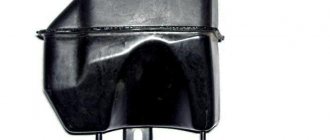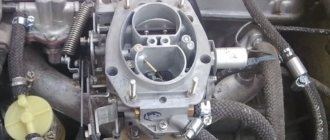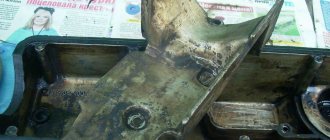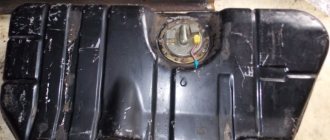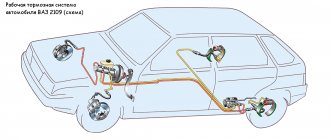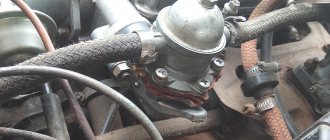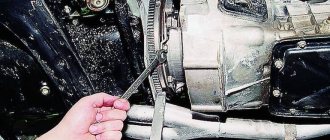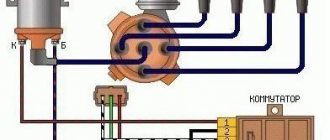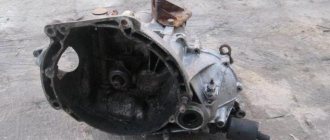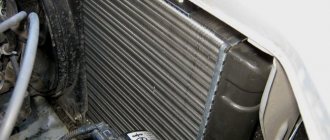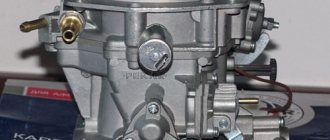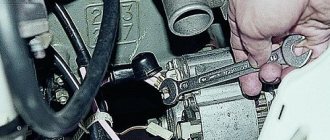From time to time, car owners have to drain gasoline from the tank. Sometimes you need a little fuel for a camper stove or to refuel another car. In other cases, it is necessary to drain all the gasoline to repair the fuel system or remove water or low-quality fuel from the tank. On older cars this operation could be done relatively easily. Now we have to face two problems:
- The long winding channel leading to the tank does not allow the hose to be pushed into it.
- A mesh installed at the filler neck prevents gasoline from draining.
Therefore, it is better to know several methods and apply them depending on the design of the gas tank and the fuel supply system. Below we will tell you how to drain gasoline from cars: VAZ 2109, 2110, 2114, 2115, Grants, Largus, Toyota, Niva, Priora, Patriot, Ford, Chevrolet.
Method 1. How to drain gasoline using a hose
The classic method that our grandfathers used. To drain the fuel you need to prepare two things:
- A hose (tube), the length of which depends on the design of the tank.
- Clean container for gasoline.
In the simplest case, the fuel pumping operation goes like this:
- Lower the hose (tube) into the tank so that it is immersed in gasoline.
- Cover the free end with your lips and draw in a strong breath.
- Direct the hose into the prepared container.
All that remains is to wait for all the fuel to flow out.
To drain only part of the fuel, it is enough to lift the hose above the neck so that gasoline stops flowing out.
Gasoline and octane boosters are harmful to health. Therefore, it is necessary to avoid their entry of fuel and its vapors into the body.
To prevent gasoline from getting onto the mucous membranes or into the stomach, special hoses are used to pump fuel. They are equipped with a bulb that must be squeezed before immersing the tube in the fuel and then released. If the design is not equipped with a check valve, vacuum in the line is created in a simple way:
- squeeze the pear;
- lower the hose into the gas tank;
- plug the hose outlet with your finger;
- release the rubber bulb;
- remove your finger.
The bulb can be replaced with an improvised piston . To do this, you will need a rope that runs freely inside the tube. It is better that it is made of soft natural material and not nylon. At the end of the rope you need to tie several knots, and then:
- Thread the rope and pull lightly so that the piston from the knots enters the hose.
- Insert the hose into the gas tank.
- Smoothly pull out the rope.
- Lower the hose (tube) into the prepared fuel container.
- remove your finger.
The moving “piston” creates a vacuum that causes gasoline to flow from the tank.
However, all tricks with a hose are only relevant for old cars. The gas tank of modern cars (Grants, Largus, Toyota, Niva, Priora, Patriot, Ford, Chevrolet) is located far from the filler neck. In this case, you need to use other methods.
Selecting a fine filter
The abundance of consumables on the market makes it difficult to choose. Surveys show that more than a third of “ten” owners use the BIG brand. The brands SCT, Bosch, Mann and Nevsky have proven themselves well.
“Experts” recommend assessing consumables visually by opening the casing. It is unlikely that such an “examination” makes sense. The differences are not fundamental; they are impossible to see with the naked eye. Universal advice - buy one that you don’t mind spending money on.
Method 2. Drain gasoline through the fuel line and the plug at the bottom of the gas tank
If the fuel pump is located not in the tank itself, but near the engine, you can try to drain the fuel through the fuel line. Procedure:
- Unscrew the clamp and disconnect the hose going from the tank to the fuel pump.
- Place the hose into the fuel container.
Fuel will leak from the gas tank. The main thing is that the end of the fuel line, as well as the fuel container, is located below the gasoline level.
Which gasoline is better - 92 or 95? What is octane number?
Some cars have gas tanks with drain plugs. If you are the owner of just such a car model, you need to use an overpass or inspection hole to drain the fuel. This is done simply:
- Place a container under the drain plug in the gas tank.
- Unscrew the plug.
- Drain the fuel (all or part of it).
- Tighten the plug.
However, plugs at the bottom of the tank are not very common. In this case, the fuel pump will help drain the gasoline. The method is suitable for old modern cars.
Stories from our readers
“Fucking basin. "
Hi all! My name is Mikhail, now I’ll tell you a story about how I managed to exchange my two-wheeler for a 2010 Camry. It all started with the fact that I began to be wildly irritated by the breakdowns of the two-wheeler, it seemed like nothing serious was broken, but damn it, there were so many little things that really started to irritate me. This is where the idea arose that it was time to change the car to a foreign car. The choice fell on the melting Camry of the tenth years.
Yes, I had matured morally, but financially I just couldn’t handle it. I’ll say right away that I am against loans and taking a car, especially not a new one, on credit is unreasonable. My salary is 24k a month, so collecting 600-700 thousand is almost impossible for me. I started looking for different ways to make money on the Internet. You can’t imagine how many scams there are, what I haven’t tried: sports betting, network marketing, and even the volcano casino, where I successfully lost about 10 thousand ((The only direction in which it seemed to me that I could make money was currency trading on the stock exchange, they call it Forex. But when I started delving into it, I realized that it was very difficult for me. I continued to dig further and came across binary options. The essence is the same as in Forex, but it’s much easier to understand. I started reading forums, studying trading strategies. I tried it on a demo account, then opened a real account. To be honest, I didn’t manage to start earning money right away, until I understood all the mechanics of options, I lost about 3,000 rubles, but as it turned out, it was a precious experience. Now I earn 5-7 thousand rubles a day. I managed to get the car buy after half a year, but in my opinion this is a good result, and it’s not about the car, my life has changed, I naturally quit my job, I have more free time for myself and my family. You’ll laugh, but I work directly on the phone)) If If you want to change your life like me, then here’s what I advise you to do right now: 1. Register on the site 2. Practice on a Demo account (it’s free). 3. As soon as you get something on the Demo account, top up your REAL ACCOUNT and go to REAL MONEY! I also advise you to download the application to your phone, it’s much more convenient to work from your phone. Download here.
Method 3. How to drain gasoline using a fuel pump
The only way to drain fuel from the tanks of most fuel-injected cars is to use the fuel pump. Open the hood and disconnect the fuel hose from the ramp pipe and direct it into a prepared fuel container.
If you then turn on the ignition, the electric pump will start for a few seconds and pump 200-300 grams of gasoline. To pump out more fuel, you need to use one of two options:
- Periodically turn the ignition on/off so that the pump pumps gasoline in small portions.
- Remove the electric pump turn-on relay and close the pump power contacts. In this case, the pump will pump gasoline until the ignition is turned off.
If you short-circuit the relay power supply circuit instead of the contacts going to the fuel pump, the fuse will blow and you will not be able to start the car . Therefore, first carefully study the wiring diagram and relay pinout.
After pumping out the fuel, do not forget to put the relay with the hose in place and tighten the clamp on the latter.
The described method is not suitable for draining all fuel from the tank. If the gasoline runs out, the fuel line will become airy and the pump may fail.
You can also drain gasoline from the tank using a mechanical fuel pump. The device has a lever for manual pumping. However, the productivity of this method is extremely low. It should be used when you need to collect 100-200 grams of gasoline.
Drain fuel from a foreign car correctly
Foreign cars have a complex structure, so it is more difficult to drain gasoline from a foreign car. For example, it is removed from a Camry using a hose. But first you will have to remove the mesh that protects the neck of the tank.
The procedure is complex, so the best option when working with a foreign car is to drain the fuel not from the tank itself, but from the system through which the fuel moves.
First, the car owner must find where the fuel line runs. Beginners should not perform the procedure on their own. The container is prepared in advance; it must be clean.
There are 2 ways to carry out the drain. The first is based on the driver first disconnecting the tube that runs in front of the pump. But you need to be prepared for the fact that the canister will fill slowly, because the diameter of the tube is small.
The second method is based on the fact that the car owner opens the tubes that go after the pump. Then he starts the engine, then the gasoline drains quickly. During the procedure, fuel should not splash onto the ground.
Practical aspects of the VAZ 2109 body
The body of the VAZ 2109 was designed as a hatchback; a revolutionary innovation was the luggage compartment, which made it possible to almost double the capacity. At the same time, the fuel consumption of the “nine” is comparatively lower than that of any SUV. On the one hand, the VAZ 2109, if necessary, can have the spaciousness of an SUV, on the other hand, low fuel consumption. All this increases the practical profitability of using this vehicle.
Of course, many owners of the VAZ 2109 regularly highlight the problem of the reliability of body fastenings: periodic squeaking, certain fastenings quickly become loose, etc. However, it is important to remember that the cost of repairing a body or replacing an individual functional fastener has an extremely low market value. If the body of modern hatchbacks is divided into large design elements, then the cost of replacing or repairing them is several orders of magnitude higher.
Watch an interesting video review of the VAZ 2109 2008
In general, the simplicity of the body structure of the VAZ 2109, small dimensions and price directly affected the degree of popularity of this car model. If we take into account today's calendar year and 1988, when the first production car was released, and the fact that the VAZ 2109 is successfully used by many motorists to this day, the question of quality immediately disappears.
The body of the VAZ 2109 is simple in structure, practical and easy to repair if necessary. You can do this, again, with your own hands according to the instructions or entrust the operation to specialists. High-quality photos and materials and a video review given in the article will help consolidate technical knowledge of the body of the Nine.
How to pay TWICE LESS for GASOLINE
But there is a completely simple way to reduce fuel consumption! Don't believe me? An auto mechanic with 15 years of experience also didn’t believe it until he tried it. And now he saves 35,000 rubles a year on gasoline! More about this
Despite the fact that today's car market is very diverse, and finding an inexpensive foreign car is not difficult, many car enthusiasts prefer domestic cars. Russian-made machines are very practical and economical to operate due to inexpensive service. Those who are ready to give up excessive comfort by buying a domestic car will make the right choice. One of the popular cars is the VAZ 2109.
The option is more complicated.
We remove the main fuel line hose from the fuel line ramp and attach our own hose to it, tighten the connection with a clamp (the pressure in the fuel line is 2-3 Atm.). Insert the end of the hose into the container. We find a block with fuses and a key relay (Usually located in the dashboard on the driver's side or under the hood closer to the battery). Using the diagram we find the fuel pump on/off relay.
We remove the relay and use a paper clip or wire to close the contacts leading to the relay. We turn on the ignition, gasoline begins to flow. If there is a lot of fuel in the tank, drain the gasoline intermittently so as not to disable the fuel pump. Immediately after air comes out of the hose, turn off the ignition (so as not to burn the fuel pump) - the tank is empty.
Reinstall the hoses and relays.
A safer way is to attach a bulb pump to the fuel line to pump out the fuel (a very long process)
To summarize, I will say on my own behalf, if you doubt your abilities, skills and professionalism, it is better to contact an official service station or call an emergency gang. Those who have at least a little experience in car repairs will easily pump out the fuel themselves after reading this article.
Difference in fuel tank design
Many car enthusiasts know that draining the fuel from the tank of a modern car is quite difficult or even impossible. In most foreign cars, as well as new-generation domestic cars, the path of gasoline from the neck to the tank is not prone to the free penetration of foreign objects, which complicates draining with a conventional hose.
But as practice shows, with proper skill and suitable equipment, you can even drain gasoline from the tank of a foreign car. To do this, you will need a rubber tube at least 3 meters long and no more than 8 mm thick. As soon as the hose hits the neck when immersed, twist it, trying to change the position of the end. It is necessary to periodically blow out the hose. As soon as you hear gurgling inside the gas tank, you can start pumping out the fuel.
It is important to try not to change the position of the hose located in the gas tank. But we do not guarantee that this method is suitable for all foreign car models
Some cars have a special drain hole in the gas tank, which simplifies access to fuel.
Law of combined vessels
In order for fuel to flow, the container being filled must be below the fuel level in the gas tank. The law of combined vessels will not work without the forced creation of an initial vacuum. There are two ways to create a vacuum in the hose:
- draw in air using your lungs. The method has long been known, but not very pleasant. It is better to use a transparent hose to control the flow of fuel, since there is a real opportunity to taste the gasoline. As soon as the liquid runs through the hose, lower it into the container;
- To pump out, attach a manual fuel pump, which is installed on diesel cars, to the hose. The cost of such a device does not exceed $5, and you can buy it in almost any automobile store;
- use an enema, which can be purchased at any pharmacy. We believe that there is no need to tell you how the enema works, so you could already guess the method of use.
We use a pump
To pump large volumes, it is best to use a special manual or electric pump. The first option is a pump combined with a pumping tank. A submersible electric pump connected to 24 V can be used to pump fuel out of a truck's gas tank. To use it on a passenger car, you will have to remove the fuel pump housing. Also among the automotive products you can find a non-submersible pump connected to 12 V. Of course, for one-time use, purchasing electric units is impractical.
Get it at any cost
Now you know how to drain the fuel from the tank. But if you couldn’t get fuel out of the hose, use the following methods:
on a car with an injection internal combustion engine, disconnect the wire going from the fuel pump to the fuel rail and place it in a container. Turning the ignition to On will start the fuel pump. But after some time the engine ECU will turn it off. To restart, turn off the ignition, then turn the key to the 3rd position again. If you need to pour fuel quickly, find the fuel pump relay (it will click when you turn the key to the On position) and remove it from the block. For continuous operation of the fuel pump, you need to close the power contacts with a paper clip. In a 4-pin relay, these are pins No. 30 and 87 (non-dialed);
- In carburetor internal combustion engines, gasoline can be drained from the supply hose running from the fuel pump to the carburetor. You can transfer fuel by turning the engine with the starter. Be careful not to drain the battery, as the car will then have to be pushed-started;
- not all diesel cars are equipped with a pumping section immersed in the tank (analogous to a fuel injection pump for an internal combustion engine). To drain the fuel, it is most convenient to disconnect the low-pressure fuel line coming after the filter and insert a manual pump into it. You can also disconnect the return line hose and then start the engine.
Design
Regardless of the brand of vehicle, each gas tank has a neck into which fuel is poured and which is closed with a screw cap with a rubber seal.
Some cars have a special lock on the tank cap. The neck is located at the rear of the car on its left or right side and is connected to the gas tank via a fuel line. It is a dense rubber hose that has different diameters depending on the brand of vehicle. New vehicles may be equipped with gasoline pumps that supply fuel to the vehicle's engine. The fuel level in such cars is controlled by electronic sensors that transmit readings to the instrument panel. Electrical wires located in such pumps do not cause a car explosion.
A special ventilation system installed in the car maintains the required level of pressure. The tank can also be equipped with a gravity shut-off valve, which will prevent fuel from spilling and igniting when the machine overturns.
Precautionary measures
When draining fuel, do not forget about safety precautions:
- It is prohibited to smoke near the drain container or pump fuel near an open fire (for example, near a fire in the forest). One random spark and you can cause trouble. Remember! Fuel is a flammable product!
- Using the “old-fashioned method” of sucking air through your mouth, remember that you can accidentally sip gasoline or diesel fuel. If this happens, rinse your mouth well with water.
- Make sure that fuel does not get on your clothing (if an accidental spark hits, your clothing may ignite).
- The hose from the fuel neck does not need to be pulled sharply so as not to break. The hose gets inside the tank easily, but the fuel valve holds it back. To pull it out without effort and nerves, lightly press the valve with a wooden block (but not a metal one, so as not to provoke a spark: fuel vapor + metal, and as a result a fire) inside the fuel neck - the hose can be pulled out freely.
- Do not forget to close the tank with a lid (fuel should not splash out while driving).
Didn't find the information you are looking for? on our forum.
For domestic cars without mesh
ATTENTION! A completely simple way to reduce fuel consumption has been found! Don't believe me? An auto mechanic with 15 years of experience also didn’t believe it until he tried it. And now he saves 35,000 rubles a year on gasoline! Read more"
The most famous method of draining fuel using a hose with a diameter of 15 mm, which was used by our grandfathers, is quite effective, although dirty. Not everyone knows how to suck gasoline into their mouth. If you are not careful, you can easily spill gasoline or drink it accidentally.
Here's how to properly drain fuel:
There is a special bulb on sale that perfectly absorbs liquid. You can use it if you don’t want to swallow gasoline.
There is another option. You need to take shoe laces and a hose of the same size. Then make a knot at the end of the laces and lower the rope into the hose. The tube is placed in the tank. As soon as you pull the cord, gasoline begins to flow through the tube. It turns out to be something like a piston like a syringe. To avoid any difficulties, it is recommended to soak the rope knot in any liquid in advance.
Gas tank capacity in Largus
The remaining technical characteristics are similar to the Largus “station wagon”.
| Options | "Universal" 7-seater | "Universal" 5-seater | "Van" | |||
| K4M/21129/ JR5 | 11189/JR5 | K4M/21129/ JR5 | 11189/JR5 | K4M/21129/ JR5 | 11189/JR5 | |
| "Luxe" | "Norma" | "Luxe" | "Standard" "Norma" | "Luxe" | "Standard" "Norma" | |
| Engine capacity | 1.6 l 16V | 1.6 l 8V | 1.6 l 16V | 1.6 l 8V | 1.6 l 16V | 1.6 l 8V |
| Number of doors | 6 | |||||
| Length, mm | 4470 | |||||
| Width, mm | 1750 | |||||
| Height without roof rails (at curb weight), mm | — | 1650 | ||||
| Height with roof rails (at curb weight), mm | 1670 | — | ||||
| Base, mm | 2905 | 2905 | ||||
| Front track, mm | 1469 | 1468 | ||||
| Rear track, mm | 1466 | 1466 | ||||
| Front overhang, mm | 795 | 795 | ||||
| Rear overhang, mm | 770 | 770 | ||||
| Ground clearance at full weight, mm | 145 (minimum ground clearance corresponds to the point under the engine mudguards) | |||||
| Trunk volume (VDA), dm3 | 135 | 560 | 2540 | |||
| Weight of the vehicle in running order, kg**, with driver | 1330… 1370 | 1260… 1345 | 1260…1275 | |||
| Permitted maximum weight (technically permissible), kg | 1810… 1850 | 1705… 1790 | 1985… 2000 | |||
| Maximum weight on the front axle (technically permissible), kg | 930 | 940 | ||||
| Maximum weight on the rear axle (technically permissible), kg | 1080 | 1160 | ||||
| Permissible total weight of a towed trailer, not equipped with brakes, kg | 650 (420 for a car without ABS) | |||||
| Permissible total weight of a towed trailer equipped with brakes, kg | 1300 | 1300 | 1300 | — | ||
| Permitted maximum weight with trailer, kg | 2650 | 2650 | 2650 | 2600 | ||
| Permissible load on the coupling device, kg | 75 | |||||
| Permissible load on the roof rack (including the weight of the rack), kg | 80 | |||||
| Maximum speed, km/h*** | 165 | 158 | 165 | 158 | 165 | 158 |
| Acceleration 0-100 km/h, s*** | 13,5 | 14,4 | 13,1 | 14,2 | 14,0 | 15,4 |
| Fuel consumption, l/100 km (combined cycle) | 9,0 | 9,5 | 9,0 | 9,3 | 9,0 | 9,3 |
| Wheels | 6.0 J15 | |||||
| Tires | 185/65R15 | |||||
| Turning diameter according to clearance, m | 11,25 | |||||
| Fuel tank volume, l | 50 |
When loading a vehicle to its full weight, the weight of the trailer should not lead to excess weight of the road train. ** The curb weight indicated in this table corresponds to the weight of the empty vehicle. *** Technical characteristics are measured using special methods, serve to compare different cars and are not operational standards!
Technical description and characteristics of the car
In April 2012, AVTOVAZ began production of a new Russian-made station wagon, Lada Largus (Lada Lapryc), which is a 2006 Dacia Logan MCV adapted for the Russian market, produced in Romania.
The car was created on the B0 platform, which served as the basis for the Logan and Sandero cars. In addition to station wagons, the plant also produces vans.
Test tests have shown that the car is well prepared for Russian operating conditions. The station wagon is available in five- and seven-seat versions. Moreover, the third row of seats can comfortably accommodate adult passengers. Thanks to folding seats, the car interior can be easily transformed to suit any needs - from a tourist trip to the transportation of large cargo. The third row of seats can be removed from the cabin, this allows you to significantly increase the volume of the luggage compartment. In the seven-seater version it is modest - only 135 liters. But the five-seater version already has 560 liters of volume. The front suspension is independent, MacPherson type with wishbones and anti-roll bar. The rear suspension is dependent with a U-shaped beam and trailing arms connecting the beam to the body.
The large wheelbase provides the car with good handling and stability on the road. The front brakes are ventilated discs, the rear brakes are drums. In expensive versions, the car is equipped with an anti-lock braking system (ABS).
The cars are equipped with a four-cylinder 8-valve petrol engine with a volume of 1.6 liters and a power of 62 kW (84 hp), or a 16-valve engine with a volume of 1.6 liters and a power of 77 kW (105 hp). Both engines meet Euro 4 emission standards. All cars are equipped with a five-speed manual transmission.
Read also: How to find out the chassis number by VIN Volvo
The car is available in three trim levels: “Norma”, “Standard” and “Lux”.
Options include a height-adjustable steering column, air conditioning, power steering (power steering), front and rear power windows, electrically adjustable and heated outside rear-view mirrors, and a CD/MP3 radio.
DISTINCTIVE FEATURES OF THE LADA Largus Cross CAR
The equipment of LADA Largus Cross cars is distinguished by increased ground clearance (by 25 mm), original wheels with a diameter of 16 inches, tires of increased size (205/55R16), original seat upholstery, decorative inserts for door trim and instrument panels, protective linings for the body, front and rear bumpers, black decorative films on the door frames, door sills with Largus Cross embossing, Largus Cross nameplate on the right tailgate.
